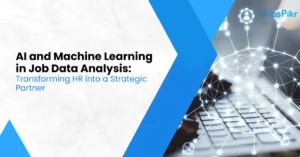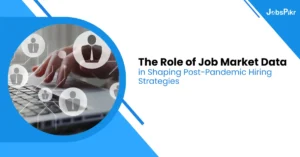A Staffing Agency has a single primary function– finding perfect matches between candidates and job postings. Its success can be measured by the number of candidates it can fit into the requirements that are posted by companies. Staffing Agencies make money when companies post jobs on their websites, and successfully find a matching candidate. They can also match jobs from the web with job seekers and take a fee in case of a successful hire.
The former method of minting money would only be possible when an Agency has scaled heights and is known for its conversion rates in a particular industry or niche. To achieve that level of recognition, you will need to start with an outstanding job-data feed, that you will need to plug into your candidate matching system.
Big Data, Machine Learning, and Staffing Agencies
Staffing Agencies need to harness the latest tech innovations like Big Data and Machine Learning to enable a small team to produce big results. Today, you could have a tech and business team of 5 people who could set up the entire Job-Matching system. You would still need to have someone to keep a check on certain parameters manually, but that effort would be greatly reduced.

An automated workflow can be created easily when you use the right tools and the right tech. In the first step, you will need some sort of job aggregator or scraper which would fetch the job-listings, clean them, normalize them and tag them. This data would then flow into the automated Job-Matching tool, which would use Big Data Analytics and Machine Learning to match jobs to candidates.
More than one candidate can be tagged to a single job and vice versa. Once this is done, the results would flow to a manual checker who would look for matches that stick out like a sore thumb. This would be required due to two major reasons:
● Resumes and Job Posts are textual content that will be analysed using Natural Language Processing– this can lead to a small percentage of errors.
● Some matches (or cases where a match was missed) may prove to be incorrect in case the model created has been overfitted or if it is not able to handle outliers.
The final result, after both the automated and manual processes, should see a very high conversion rate. Like every other AI-based approach, this too would mature over time, and the overall accuracy of your system is expected to increase. While some manual effort remains, it is necessary and is a fraction of what may have been needed if the entire workflow was being managed by individuals handling each stage.
Setting up such a system may look complicated at first, but if you opt for some Cloud-Based solutions to handle most of these stages, even a 2 member frontend-backend team could build out your entire workflow.
Data Sources– the Good, the Bad and the Ugly
You can opt for different job data sources, but where you fetch the data from is just as important as how you fetch it. When gathering job data, you can target:
- Individual Company Websites with “Careers” page
- Job Boards or feeds from other Online Job Agencies
- Job Aggregators
- New Age hiring websites like Linkedin
Job Boards and Feeds from Online Job agencies would fall under the bad category. You can target these websites for fetching jobs of a niche or a geographical region or an industry since they usually have a very targetted audience. The only drawback, in this case, is having to plug in tens of boards and websites. This would be required since you would preferably want to cover more sectors, to diversify yourself and minimize market dependant risks.
As for the ugly, scraping individual company pages may not prove very useful on a large scale. You would need to target thousands of websites and it may take months to set up your workflow. Also, in case you have even a few hundred websites from which you are pulling data, some of them may change their UI every few weeks– which would make maintaining the entire system, a challenging process.

The good, or rather the best solution here, is to fetch data from Job Aggregators and new-age alternative sites. This is because both solutions will give you access to job data from across the globe and help you get your hands into different sectors and niches. This way you wouldn’t need to worry about which industry is facing a downward spiral at which point in time.
When Covid-19 struck, there was an immediate pause in hiring in industries like aviation and hospitality. At the same time, logistics and online-businesses were hiring new employees (both regular and contractual), every single week. When you cover a broad geographical base, along with multiple industries, as a staffing agency, you’re insuring yourself against unprecedented times.
Getting the Data
While you may decide to fetch your data from any online source or website, the tool you use to get your data may make or break your agency. You could choose from a multitude of options here– DaaS solutions, writing your web scraping code, using No-Code softwares, Browser Extensions, Screen Grabbing Applications, and more.
Using each of the tools given above would involve some amount of effort from your side as well. The more basic the tool you use, the more effort you’d have to put in, to integrate with your business workflow. At the lowest rung is DIY tools and coding your solution– in both cases, you will need to handle data quality issues, along with debugging errors and setting up the infrastructure. Browser Extensions or Screen Grabbers would be too time-consuming to be used in a commercial job-aggregation task. Paid tools may be able to get a lot of the job done, but would still come with some constraints, a learning curve, and a fixed flat fee.
JobsPikr comes to the rescue
This is where you will find an automated Job Discovery tool helpful. Our offering, JobsPikr, helps you source jobs and filter them using tags like skills, years of experience, category, and more. This in turn would help you generate leads and match profiles better. Being able to aggregate quality job listings from multiple sites, and update them in real-time, is our specialty.
Staffing agencies also need to make sure that the job-data at hand isn’t stale. You wouldn’t want to spend time and resources on matching candidates with job posts that have expired. It would also create a bad experience for job seekers. To solve this problem, JobsPikr fetches jobs in real-time, and you would be notified as and when jobs go stale.
Our job data feeds are also easier to integrate since we offer multiple file formats like CSV and JSON as well as storage formats like Dropbox and S3. We do not follow a set path when creating a solution for a business but tailor it based on the end-use of the job-data. This can greatly help Staffing Agencies that want to use large datasets of job data with proper tags to improve conversions and become the preferred hiring partner for companies.




